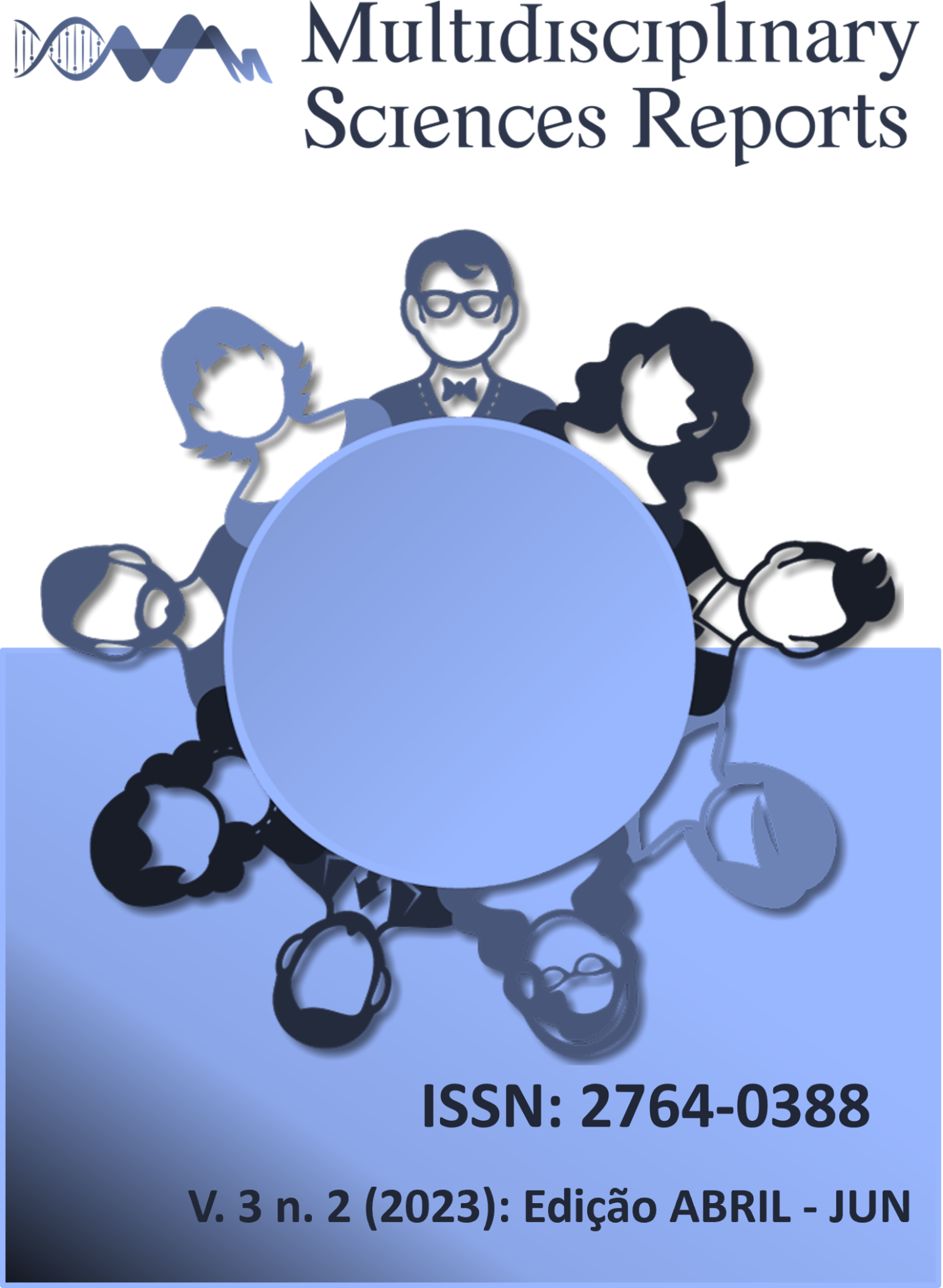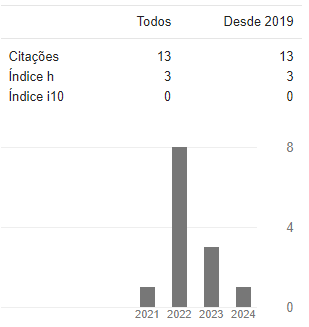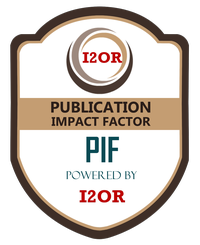Café interrompe a jornada de pseudomonadas: uma pausa para reflexão
Visualizações: 286DOI:
https://doi.org/10.54038/ms.v3i2.40Palavras-chave:
Pseudomonas aeruginosa, cafeína, motilidade, biofilmeResumo
Pseudomonas aeruginosa é um patógeno crítico de acordo com a lista de bactérias prioritárias da OMS. Ele é nutricionalmente versátil e expressa diferentes fatores de virulência, que contribuem para sua resiliência a estresses ambientais, bem como sua tolerância e resistência a antimicrobianos. Isso demanda a busca de estratégias para combater o crescimento microbiano, cenário em que compostos bioativos naturais estão sendo amplamente investigados. Neste trabalho, a atividade da cafeína sobre a motilidade e adesão de biofilme a superfícies de vidro e plástico foram testadas com duas linhagens de P. aeruginosa: TGC-04 (selvagem) e ATCC 9027 (padrão). Ambas aderiram fracamente às superfícies testadas. A linhagem padrão apresentou redução na adesão ao plástico e ao vidro de 46,9 e 65,0%, respectivamente, enquanto a linhagem selvagem não foi afetada pela cafeína (1024 μg/mL). Além disso, houve inibição em dois de três tipos de ensaios de motilidade testadas. Os resultados sugerem que a origem da linhagem pode ser um fator importante na suscetibilidade de P. aeruginosa à cafeína.
Referências
Oliveira ADL, Vasconcelos U, Calazans GMT. Detection of potential pathogenic Pseudomonas aeruginosa in a hospital water system. Res J Pharm Biol Chem Sci 2021; 12(4): 132-139.
Sales-Neto JM, Lima EA, Cavalcante-Silva LHA, Vasconcelos U, Rodrigues-Mascarenhas S. Anti-inflammatory potential of pyocyanin in LPS-stimulated murine macrophages. Immunopharmacol Immunotoxicol 2019; 41(1): 102-108, doi: 10.1080/08923973.2018.1555845. DOI: https://doi.org/10.1080/08923973.2018.1555845
Pang Z, Raudonis R, Glick BR, Lin TJ, Cheng Z. Antibiotic resistance in Pseudomonas aeruginosa: mechanisms and alternative therapeutic strategies. Biotechnol Adv 2019; 37(1): 177-192. DOI: https://doi.org/10.1016/j.biotechadv.2018.11.013
Mulcahy LR, Vincent IM, Lewis K. Pseudomonas aeruginosa biofilms in disease. Microb Ecol 2014; 68(1): 1-12, doi: 10.1007/s00248-013-0297-x. DOI: https://doi.org/10.1007/s00248-013-0297-x
Harmsen M, Yang L, Pamp SJ, Tolker-Nielsen T. An update on Pseudomonas aeruginosa biofilm formation, tolerance, and dispersal. Immunol Med Microbiol 2010; 59: 253–268. DOI: https://doi.org/10.1111/j.1574-695X.2010.00690.x
Kauffmann C, Soares APV, Arossi K, Pacheco LA, Buhl B, Freitas EM, Hoehne L, Castro LC, Gnoatto SCB, Ethur EM. Potential antimicrobial and antibiofilm in vitro of species from Eugenia genus, Myrtaceae, natives from southern of Brazil. Caderno Pedagógico 2017; 14(2): 110-127. DOI: https://doi.org/10.22410/issn.1983-0882.v14i2a2017.1512
Pereira DS, Freitas CIA, Freitas MO, Maracajá PB, Silva JBA, Silva RA, Silveira DC. History and main uses of bee propolis. ACSA 2015; 11(2): 1-21. DOI: https://doi.org/10.30969/acsa.v11i2.652
Pragana LG, Silva ES, Vasconcelos U. Exploração do potencial da cafeína como ativo antibiofilme em Pseudomonas aeruginosa na década de 2010. Int J Develop Res 2020; 10(7): 37869-37874.
Turnbull D, Rodricks JV, Mariano GF, Chowdhury F. Caffeine and cardiovascular health. Reg Toxicol Pharmacol 2017; 89: 165-185. DOI: https://doi.org/10.1016/j.yrtph.2017.07.025
Gebeyehu BT, Bikila SL. Determination of caffeine content and antioxidant activity of coffee. Am J Appl Chem 2015; 3(2): 69-76. DOI: https://doi.org/10.11648/j.ajac.20150302.16
Aquino FWB, Amorim AGN, Prata LF, Nascimento RF. Determinação de aditivos, aldeídos furânicos, açúcares e cafeína em bebidas por cromatografia líquida de alta eficiência: validação de metodologias. Ciênc Tecnol Alim 2004; 24(1): 32- 38. DOI: https://doi.org/10.1590/S0101-20612004000100007
Reyes CM, Cornelis MC. Caffeine in the diet: Country-level consumption and guidelines. Nutrients 2018; 10: 1772, doi:10.3390/nu10111772. DOI: https://doi.org/10.3390/nu10111772
Dotsey RP, Moser EAS, Eckert GJ, Gregory RL. Effects of cola-flavored beverages and caffeine on Streptococcus mutans biofilm formation and metabolic activity. J Clin Pediatr Dent 2017; 41(4): 294-299. DOI: https://doi.org/10.17796/1053-4628-41.4.294
AlEraky DM, Abuohashish HM, Gad MM, Alshuyukh MH, Bugshan AS, Almulhim KS, Mahmoud MM. The antifungal and antibiofilm activities of caffeine against Candida albicans on polymethyl methacrylate denture base material. Biomedicines 2022; 10(9): 2078, doi: 10.3390/biomedicines10092078. DOI: https://doi.org/10.3390/biomedicines10092078
Araque P, Casanova H, Ortiz C, Henao B, Pelaez C. Insecticidal activity of caffeine aqueous solutions and caffeine oleate emulsions against Drosophila melanogaster and Hypothenemus hampei. J Agric Food Chem 2007; 55(17): 6918-6922. DOI: https://doi.org/10.1021/jf071052b
Carneiro JES, Geraldine RM, Silbveira MFA, Torres MCL, Carrim AJI, Souza ARM. Antimicrobial activity and physical properties of biodegradable films added with caffeine and acetic acid. Braz J Develop 2020; 6(8): 60252-60262. DOI: https://doi.org/10.34117/bjdv6n8-443
Chakraborty P, Dastidar DG, Paul P, Dutta S, Basu D, Sharma SR, Basu S, Sarker RK, Sen A, Sarkar A, Tribedi P. Inhibition of biofilm formation of Pseudomonas aeruginosa by caffeine: a potential approach for sustainable management of biofilm. Arch Microbial 2020; 202: 623-635. DOI: https://doi.org/10.1007/s00203-019-01775-0
Kabir F, Katayama S, Tanji N, Nakamura S. Antimicrobial effects of chlorogenic acid and related compounds. J Korean Soc Appl Biol Chem 2014; 57: 359-365. DOI: https://doi.org/10.1007/s13765-014-4056-6
Lou Z, Wang H, Zhu S, Ma C, Wang Z. Antibacterial activity and mechanism of action of chlorogenic acid. J Food Sci 2011; 76: 398-403. DOI: https://doi.org/10.1111/j.1750-3841.2011.02213.x
Dash SS, Gummadi SN. Inhibitory effect of caffeine on growth of various bacterial strains. Res J Microbiol 2008; 3(6): 457-462. DOI: https://doi.org/10.3923/jm.2008.457.465
Norizan SNM, Yin W-F, Chan KG. Caffeine as a potential quorum sensing inhibitor. Sensors 2013; 13: 5117-5129. DOI: https://doi.org/10.3390/s130405117
Qais FA, Khan MS, Ahmad I. Broad-spectrum quorum sensing and biofilm inhibition by green tea against gram-negative pathogenic bacteria: Deciphering the role of phytocompounds through molecular modelling. Microbial Pathogen. 2019; 126: 379-392. DOI: https://doi.org/10.1016/j.micpath.2018.11.030
Rémy B, Mion S, Plener L, Elias M, Chabrière E, Daudé D. Interference in bacterial quorum sensing: A biopharmaceutical perspective. Front Pharmacol 2018; 9: 203, doi: 10.3389/fphar.2018.00203. DOI: https://doi.org/10.3389/fphar.2018.00203
Hadacek F, Greger H. Testing of antifungal natural products: methodologies, comparability of results and assay choice. Phytochem Anal Int J Plant Chem Biochem Tech 2000; 11(3): 137-147. DOI: https://doi.org/10.1002/(SICI)1099-1565(200005/06)11:3<137::AID-PCA514>3.0.CO;2-I
Pffaler MA, Rhine-Chalberg J, Barry AL, Rex JH. Strain variation and antifungal susceptibility among bloodstream isolates of Candida species from 21 different medical institutions. Clin Infect Dis 1995; 21: 1507–1509. DOI: https://doi.org/10.1093/clinids/21.6.1507
Canillac N, Mourey A. Antibacterial activity of the essential oil of Picea excelsa on Listeria, Staphylococcus aureus and coliform bacteria. Food Microbiol 2001; 18: 261-268. DOI: https://doi.org/10.1006/fmic.2000.0397
Khare E, Arora NK. Dual activity of pyocyanin from Pseudomonas aeruginosa – antibiotic against phytopathogen and signal molecule for biofilm development by rhizobia. Can J Microbiol 2011; 57(9): 708-713. DOI: https://doi.org/10.1139/w11-055
Rodrigues LB, Santos LR, Tagliari VZ, Rizzo NN, Trenhago G, Oliveira AP, Goetz F, Nascimento VP. Quantification of biofilm production on polystyrene by Listeria, Escherichia coli and Staphylococcus aureus isolated from a poultry slaughterhouse. Braz J Microbiol 2010; 41: 1082-1085. DOI: https://doi.org/10.1590/S1517-83822010000400029
Pagano PJ, Buchanan LV, Dailey CF, Haas JV, Enk RAV, Gibson JK. Effects of linezolid on Staphylococcal adherence versus time of treatment. Int J Antimicrob Agents, 2004; 23 226–234. DOI: https://doi.org/10.1016/j.ijantimicag.2003.07.012
Rashid MH, Kornberg A. Inorganic polyphosphate is needed for swimming, swarming, and twitching motilities of Pseudomonas aeruginosa. Proc Natl Acad Sci USA 2000; 97(9): 4885-4890. DOI: https://doi.org/10.1073/pnas.060030097
Jadeja N, Changela D, Dangar K, Bhatt A, Raval M. An approach towards Quorum inhibition in pathogen Pseudomonas aeruginosa by herbal plant extracts and phytochemicals. Proc Nat Conf Innovat Biol Sci 2020; doi: 10.2139/ssrn.3572636. DOI: https://doi.org/10.2139/ssrn.3572636
Zandoná GP, Bagatini L, Woloszyn N, Souza-Cardoso J, Hoffmann JF, Moroni LS, Stefanello FM, Junges A, Rombaldi CV. Extraction and characterization of phytochemical compounds from araçazeiro (Psidium cattleianum) leaf: Putative antioxidant and antimicrobial properties. Food Res Int 2020; 137: 109573, doi: 10.1016/j.foodres.2020.109573. DOI: https://doi.org/10.1016/j.foodres.2020.109573
Hoffmann JF, Zandoná GP, Santos PS, Dallmann CM, Madruga FB, Rombaldi CV, Chaves FC. 2017. Stability of bioactive compounds in butiá (Butia odorata) fruit pulp and nectar. Food Chem 2017; 237: 638-644, doi: 10.1016/j.foodchem.2017.05.154. DOI: https://doi.org/10.1016/j.foodchem.2017.05.154
Moradali MF, Ghods S, Rehm BH. Pseudomonas aeruginosa lifestyle: a paradigm for adaptation, survival, and persistence. Front Cell Infect Microbiol 2017; 7: 39, doi: 10.3389/fcimb.2017.00039. DOI: https://doi.org/10.3389/fcimb.2017.00039
Romling U, Balsalobre C. Biofilm infections, their resilience to therapy and innovative treatment strategies. J Intern Med 2012; 272: 541–561. DOI: https://doi.org/10.1111/joim.12004
Kariminik A, Baseri-Salehi, M, Kheirkhah B. Pseudomonas aeruginosa quorum sensing modulates immune responses: an updated review article. Immunol Lett 2017; 190: 1-6. DOI: https://doi.org/10.1016/j.imlet.2017.07.002
Woolfolk CA. Metabolism of N-methylpurines by a Pseudomonas putida strain isolated by enrichment on caffeine as the sole source of carbon and nitrogen. J Bacteriol 1975; 123(3): 1088-1106. DOI: https://doi.org/10.1128/jb.123.3.1088-1106.1975
Gokulakrishnan S, Chandraraj K, Gummadi SN. A preliminary study of caffein degradation by Pseudomonas sp. GSC1182. Int J Food Microbiol 2007; 113(3): 346-350. DOI: https://doi.org/10.1016/j.ijfoodmicro.2006.07.005
Larsson DGJ, Flach C-F. Antibiotic resistance in the environment. Nat Rev Microbiol 2022; 20(5): 257-269. DOI: https://doi.org/10.1038/s41579-021-00649-x
Cavalcanti TG, Souza AF, Ferreira GF, Dias DSB, Severino LS, Morais JPS, Sousa KA, Vasconcelos U. Use of agro-industrial waste in the removal of phenanthrene and pyrene by microbial consortia in soil. Waste Biomass Valor 2019; 10(1): 205-214. DOI: https://doi.org/10.1007/s12649-017-0041-8
Becerra MVG, Valdez AG, Martinez MJG, Morales E, González LS, Méndez JL, Delgado G, Espinosa RM, Soto GYP, Yañez MC, Chávez GS. Pseudomonas aeruginosa ATCC 9027 is a non-virulent strain suitable for mono-rhamnolipids production. Appl Microbiol Biotechnol 2016; 100(23): 9995–10004. DOI: https://doi.org/10.1007/s00253-016-7789-9
Ramanaviciene A, Mostovojus V, Bachmatova I, Ramanavicius A. 2003. Antibacterial effect of caffeine on Escherichia coli and Pseudomonas fluorescens. Acta Med Litu 2003; 4(10): 185–188.
Krasowska A, Sigler K. How microorganisms use hydrophobicity and what does this mean for human needs? Front Cell Infect Microbiol 2014; 4: 112, doi: 10.3389/fcimb.2014.00112. DOI: https://doi.org/10.3389/fcimb.2014.00112
Ubbink J, Zammaretti PS. Colloidal properties and specific interactions of bactérias surfaces. Curr Opin Colloid Interf Sci 2007; 12(4): 263-270. DOI: https://doi.org/10.1016/j.cocis.2007.08.004
Desrousseaux C, Sautou V, Descamps S, Traoré O. Modification of the surfaces of medical devices to prevent microbial adhesion and biofilm formation. J Hosp Infect 2013; 85(1): 87-93. DOI: https://doi.org/10.1016/j.jhin.2013.06.015
Campoccia D, Cangini I, Selan L, Vercellino M, Montanaro L, Visai L, Arciola CR. An overview of the methodological approach to the in vitro study of antiinfective biomaterials. Int J Artif Organs 2012; 35(10): 800-816. DOI: https://doi.org/10.5301/ijao.5000140
Gargiulo G, Bradford SA, Simunek J, Ustohal P, Vereecken H, Klumpp E. Bacteria transport and deposition under unsaturated flow conditions: the role of water content and bacteria surface hydrophobicity. Vadose Zone J 2008; 7(2): 406-419. DOI: https://doi.org/10.2136/vzj2007.0068
Zhong H, Jiang Y, Zeng G, Liu Z, Liu L, Liu Y, Yang X, Lai M, He Y. Effect of low concentration rhamnolipid on adsorption of Pseudomonas aeruginosa ATCC 9027 on hydrophilic and hydrophobic surfaces. J Hazard Mater, 2015; 285: 383-388. DOI: https://doi.org/10.1016/j.jhazmat.2014.11.050
Delcour AH. Outer membrane permeability and antibiotic resistance. Biochim Biophys Acta 2009; 1794(5): 808-816. DOI: https://doi.org/10.1016/j.bbapap.2008.11.005
Oliveira BTM, Lima KYG, Arruda RRA, Vasconcelos U. Distinct stress responses to pyocyanin by planktonic and sessile Staphylococcus aureus UFPEDA 02 and Escherichia coli UFPEDA 224. Braz J Develop, 2021; 7(10): 98074-8088. DOI: https://doi.org/10.34117/bjdv7n10-227
Norat CET, Pragana LG, Jaramillo LYA, Travassos RA, Vasconcelos U. Hydrocarbonoclastic activity in bacterial biofilms: a systematic study emphasazing pseudomonads. Conjecturas 2022; 12(22): 548-562. DOI: https://doi.org/10.53660/CONJ-1568-2D01
Souza IA, Garcia DO, Anversa L, Katsuko R, Kobayashi T, Nakazato G, Saeki EK. Comparative analysis of the virulence factors in Pseudomonas aeruginosa strains isolated from clinical and environmental. Colloquium Vitae, 2019; 11(3): 41-50. DOI: https://doi.org/10.5747/cv.2019.v11.n3.v269
Khan N, Mendonça L, Dhariwal A, Fontes G, Menzies D, Xia J, Divangahi M, King IL. Intestinal dysbiosis compromises alveolar macrophage immunity to Mycobacterium tuberculosis. Mucosal Immunol 2019; 12(3): 772-783. DOI: https://doi.org/10.1038/s41385-019-0147-3
O’Toole GA, Kolter R. Pseudomonas aeruginosa biofilm development. Mol Microbiol, 1998; 30(2): 295-304. DOI: https://doi.org/10.1046/j.1365-2958.1998.01062.x
Rossi C, Serio A, López CC, Anniballi F, Auricchio B, Goffredo E, Goga BTC, Lista F, Fillo S, Paparella A. Biofilm formation, pigment production and motility in Pseudomonas spp., isolated from the dairy industry. Food Control 2018; 86: 241-248. DOI: https://doi.org/10.1016/j.foodcont.2017.11.018
Shrout JD, Chopp DL, Just CL, Hentzer M, Givskov M, Parsek MR. The impact of quorum sensing and swarming motility on Pseudomonas aeruginosa biofilm formation is nutritionally conditional. Molec Microbiol 2006; 62(5): 1264-1277. DOI: https://doi.org/10.1111/j.1365-2958.2006.05421.x
Barceló IM, Jordana-Lluch E, Escobar-Salom M, Torrens G, Fraile-Ribot PA, Cabot G. Role of enzymatic activity in the biological cost associated with the production of AmpC β-Lactamases in Pseudomonas aeruginosa. Microbiol Spectr 2002; 10(5): 1-20, doi: 10.1128/spectrum.02700-22 1. DOI: https://doi.org/10.1128/spectrum.02700-22
Burrows LL. Pseudomonas aeruginosa twitching motility: type IV pili in action. Annu Rev Microbiol 2012; 66: 493-520. DOI: https://doi.org/10.1146/annurev-micro-092611-150055
Downloads
Publicado
Como Citar
Edição
Seção
Dados de financiamento
-
Fundação de Apoio à Pesquisa do Estado da Paraíba
Números do Financiamento Bolsa de Mestrado
Accepted 2023-05-16
Published 2023-06-07














